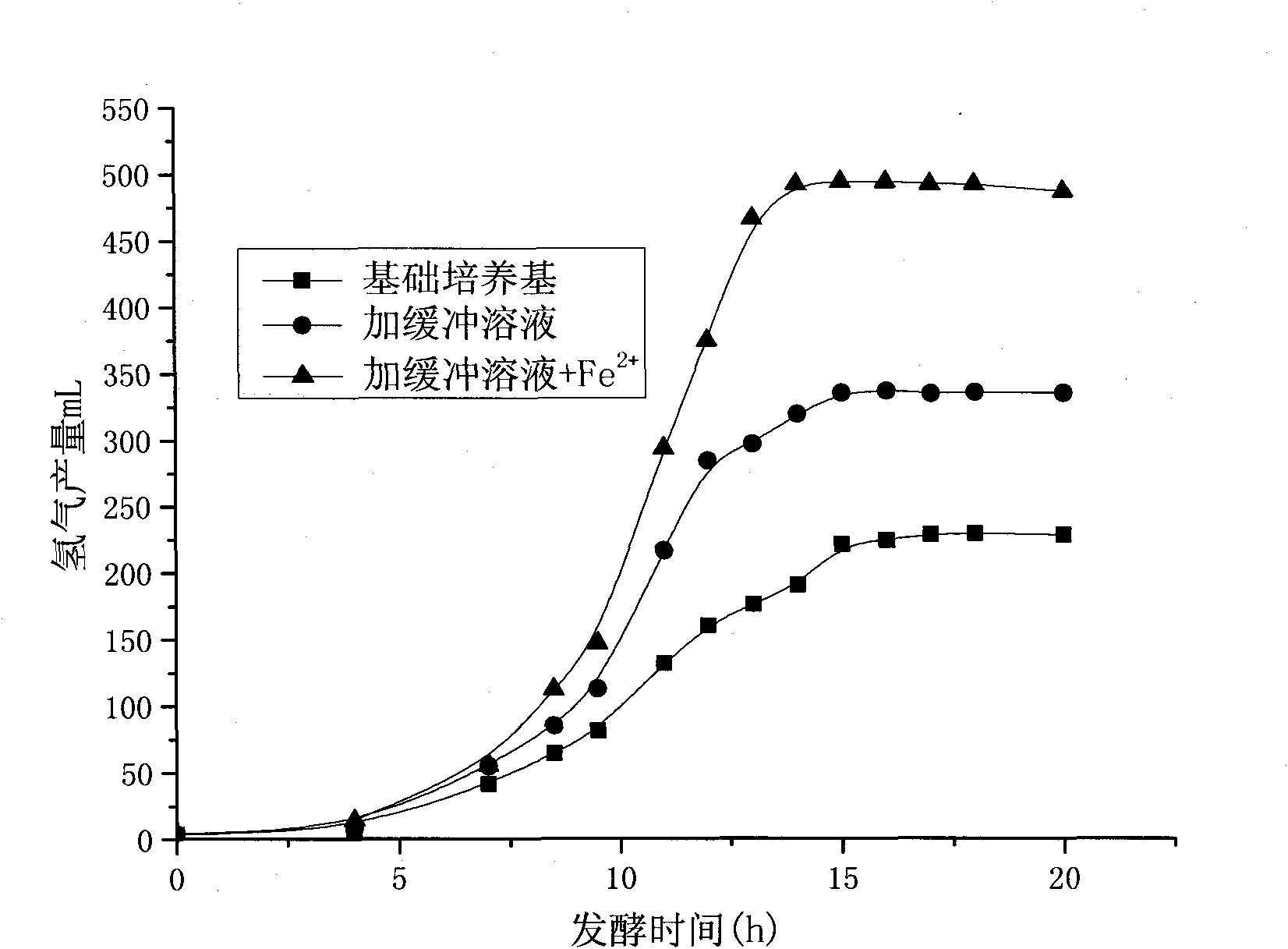Method for producing hydrogen by utilizing facultative anaerobe fermentation
A facultative anaerobic bacteria and fermentation substrate technology, applied in the field of biological hydrogen production, can solve the problems of strict fermentation conditions and complex operation of biological hydrogen production
- Summary
- Abstract
- Description
- Claims
- Application Information
AI Technical Summary
Problems solved by technology
Method used
Image
Examples
Embodiment 1
[0026] Embodiment 1: Selection and determination of bacterial strain inoculation methods
[0027] The medium components are: peptone 5g / L, beef extract 3g / L, NaCl 5g / L, adjust the initial pH=7.0, and use this as the basic medium; all sterilization is performed at 115°C for 25 minutes;
[0028](1) Scheme 1: prepare the basic medium and sterilize it, inoculate the Enterobacter aerogenes high-concentration bacterial solution in the basic medium with a volume ratio of 2% to 5% (aseptic operation), and inoculate the base medium at a temperature of 30°C and 170r / min After 24-48 hours of shaking culture on a shaking table, transfer the cultured bacterial liquid to the sterilized glucose fermentation substrate with a concentration of 20g / L. The total amount of the fermentation liquid is 450mL. 170r / min shaker shake culture, and connect the hydrogen collection device.
[0029] (2) Scheme 2: Add glucose to the base medium at a ratio of 20g / L as a fermentation substrate, obtain a cultur...
Embodiment 2
[0032] Embodiment 2: Determination of optimal fermentation base component configuration
[0033] According to the result of embodiment 1, on the basis of application scheme two, further optimize fermentation condition, explore the best fermentation medium component configuration, carry out following test:
[0034] Three kinds of fermentation media were prepared respectively, numbered 1 to 3, and their compositions were shown in the table below:
[0035] Medium No.
Glucose 20g / L
Peptone 5g / L
Beef Extract 3g / L
NaCl 5g / L
K 2 HPO 4 1.5g / L
FeSO 4 4H 2 O 0.2g / L
1
+
+
+
+
2
+
+
+
+
+
3
+
+
+
+
+
+
[0036] Adjust the initial pH of the fermentation medium to 7.0, sterilize at 115°C for 25 minutes, inoculate Enterobacter aerogenes high-concentration bacterial liquid at a volume ratio of 2% to 5% (aseptic op...
Embodiment 3
[0038] Embodiment 3: the determination of optimum fermentation substrate concentration
[0039] According to the results of Examples 1 and 2, the possibility of improving the hydrogen production efficiency was explored by changing the initial concentration of the fermentation substrate.
[0040] Prepare basal medium, consisting of: peptone 5g / L, beef extract 3g / L, NaCl 5g / L, K 2 HPO 4 1.5g / L, FeSO 4 4H 2 O 0.2g / L, set 4 groups of parallel experiments, set the initial substrate glucose concentration as 5, 10, 20, 30, 40 and 60g / L respectively, the total fermentation liquid volume is 450mL, other fermentation conditions are all the same. Before the start of the culture, they were purged with nitrogen for 3-5 minutes to an anaerobic or near-anaerobic environment, placed on a shaker at a temperature of 40 ° C, 170 r / min for shaking culture and connected to a hydrogen collection device, and the duration was 20 hours. The gas is collected during the fermentation process, and the...
PUM
| Property | Measurement | Unit |
|---|---|---|
| decomposition efficiency | aaaaa | aaaaa |
Abstract
Description
Claims
Application Information
 Login to View More
Login to View More - R&D
- Intellectual Property
- Life Sciences
- Materials
- Tech Scout
- Unparalleled Data Quality
- Higher Quality Content
- 60% Fewer Hallucinations
Browse by: Latest US Patents, China's latest patents, Technical Efficacy Thesaurus, Application Domain, Technology Topic, Popular Technical Reports.
© 2025 PatSnap. All rights reserved.Legal|Privacy policy|Modern Slavery Act Transparency Statement|Sitemap|About US| Contact US: help@patsnap.com



